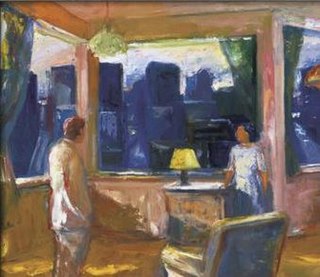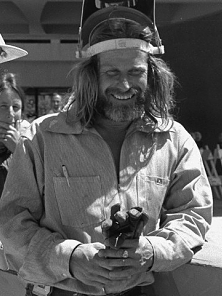
Elmer Nelson Bischoff, was an American visual artist, from the San Francisco Bay Area. Bischoff, along with Richard Diebenkorn and David Park, was part of the post-World War II generation of artists who started as abstract painters and found their way back to figurative art.

Marco Polo di Suvero, better known as Mark di Suvero, is an abstract expressionist sculptor and 2010 National Medal of Arts recipient.
The Bay Area Figurative Movement was a mid-20th Century art movement made up of a group of artists in the San Francisco Bay Area who abandoned working in the prevailing style of Abstract Expressionism in favor of a return to figuration in painting during the 1950s and onward into the 1960s.

John Harvey McCracken was a minimalist artist. He lived and worked in Los Angeles, Santa Fe, New Mexico, and New York.
Robert H. Colescott was an American painter. He is known for satirical genre and crowd subjects, often conveying his exuberant, comical, or bitter reflections on being African American. He studied with Fernand Léger in Paris. Colescott's work is in many major public collections, including those of the Museum of Modern Art in New York, the Corcoran Gallery of Art, the San Francisco Museum of Modern Art, the Museum of Fine Arts, Boston, the Hirshhorn Museum and Sculpture Garden, the Baltimore Museum of Art and the Crystal Bridges Museum of American Art.

Robert Carston Arneson was an American sculptor and professor of ceramics in the Art department at University of California, Davis for nearly three decades.

Jedd Garet is an American sculptor, painter and printmaker, who was born in 1955. He was raised in California, studied at the Rhode Island School of Design, and received a BFA from the School of Visual Arts in New York City.

John Buck is an American sculptor and printmaker who was born in Ames, Iowa.

Funk art is an American art movement that was a reaction against the nonobjectivity of abstract expressionism. An anti-establishment movement, Funk art brought figuration back as subject matter in painting again rather than limiting itself to the non-figurative, abstract forms that abstract expressionists such as Jackson Pollock and Mark Rothko were depicting. The movement's name was derived from the jazz musical term "funky", describing the passionate, sensuous, and quirky. During the 1920s, jazz was thought of as very basic, unsophisticated music, and many people believed Funk was an unrefined style of art as well. The term funk also had negative connotations because the word had an association with a foul odor. Throughout the 1960s and 1970s, Funk was a popular art form, mainly in California's Bay Area in the United States. Although discussed as a cohesive movement, Funk artists did not feel as if they belonged to a collective art style or group. This is because while its artists shared the same attitudes and created similar works, they were not necessarily working together.
Fletcher C. Benton was an American sculptor and painter from San Francisco, California. Benton was widely known for his kinetic art as well as his large-scale steel abstract geometric sculptures.

Robert H. Hudson is an American visual artist. He is known for his funk art assemblage metal sculptures, but he has also worked in painting and printmaking.
Peter Forakis was an American artist and professor. He was known as an abstract geometric sculptor.
Squeak Carnwath is an American contemporary painter and arts educator. She is a professor emerita of art at the University of California, Berkeley. She has a studio in Oakland, California, where she has lived and worked since 1970.
JB Blunk (1926–2002) was a sculptor who worked primarily in wood and clay. In addition to the pieces he produced in wood and ceramics, Blunk worked in other media, including jewelry, furniture, painting, bronze, and stone.
Bruce Beasley is an American abstract expressionist sculptor born in Los Angeles and currently living and working in Oakland, California. He attended Dartmouth College from 1957–59, and the University of California, Berkeley from 1959-62 where he earned his BA.

Frank Lobdell (1921–2013) was an American painter, often associated with the Bay Area Figurative Movement and Bay Area Abstract Expressionism.

Spalding House, also known as the Cooke-Spalding House was an art museum and sculpture garden in Honolulu, Hawaii. It was called Nuumealani by Anna Rice Cooke, who commissioned it. The house and gardens constituted a 3+1⁄2-acre former art museum in the Makiki Heights district of Honolulu.
Kay Sekimachi is an American fiber artist and weaver, best known for her three-dimensional woven monofilament hangings as well as her intricate baskets and bowls.
Fred Thomas Martin was an American artist, writer and arts administrator and educator who was active in the San Francisco Bay Area art scene since the late 1940s, He was a driving force of the Bay Area art scene from the mid 1950s until his retirement from the San Francisco Art Institute. In addition to his artistic practice, Martin was widely known for his work as a longtime administrator and Professor Emeritus at the San Francisco Art Institute (SFAI).

Brian Wall is a British-born American sculptor now living in California. His work consists mainly of abstract welded steel constructions, and his career stretches over six decades. He has had numerous solo shows, and his sculptures reside in many private and museum collections. He was a faculty member at the Central School of Art in London, and a professor of art at the University of California, Berkeley.










